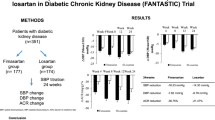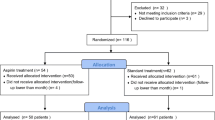Abstract
Cilostazol is an antiplatelet, antithrombotic agent with anti-inflammatory properties. To date, no clinical study has specifically evaluated the efficacy of cilostazol in patients with diabetic nephropathy (DN). We hypothesized that cilostazol might delay renal deterioration in DN patients at high risk of progression. Between April 2008 and April 2010, we screened 156 consecutive patients aged 35–80 years who were first diagnosed with type 2 diabetes after the age of 30 years. Of these, 90 patients with DN, as defined by morning spot urine microalbuminuria (MAU) >20 mg/L or an albumin-to-creatinine ratio (ACR) >30 μg/mg on at least two consecutive occasions within the prior 3 months, were enrolled into a 52-week randomized, single-blinded, placebo-controlled trial of oral cilostazol 100 mg twice daily or placebo (45 subjects in each group). Morning spot urine samples were collected to determine MAU and ACR. Fasting plasma levels of metabolic, endothelial variables, and inflammatory markers were examined. Following 52 weeks of treatment, urinary MAU and ACR were significantly reduced in the cilostazol group compared with the placebo group (P = 0.024 and P = 0.02, respectively). In regression analyses, changes in monocyte chemotactic protein-1, E-selectin, and soluble vascular cell adhesion molecule-1 (sVCAM-1) were significantly associated with changes in MAU and ACR. Net changes of E-selectin (P < 0.001) and sVCAM-1 (P < 0.05) were independent predictors of change in MAU and ACR, respectively. Our results suggest that cilostazol may effectively attenuate deterioration of albuminuria in patients with type 2 diabetes. This effect is likely mediated by an improvement of adhesion molecules.


Similar content being viewed by others
References
C.E. Lok, M.J. Oliver, D.M. Rothwell, J.E. Hux, The growing volume of diabetes-related dialysis: a population based study. Nephrol. Dial. Transplant. 19, 3098–3103 (2004)
G. Jerums, S. Panagiotopoulos, E. Premaratne, R.J. MacIsaac, Integrating albuminuria and GFR in the assessment of diabetic nephropathy. Nat. Rev. Nephrol. 5, 397–406 (2009)
G. Remuzzi, A. Schieppati, P. Ruggenenti, Clinical practice. Nephropathy in patients with type 2 diabetes. N. Engl. J. Med. 346, 1145–1151 (2002)
A.I. Adler, R.J. Stevens, S.E. Manley, R.W. Bilous, C.A. Cull, R.R. Holman, UKPDS Group, Development and progression of nephropathy in type 2 diabetes: the United Kingdom Prospective Diabetes Study (UKPDS 64). Kidney Int. 63, 225–232 (2003)
M.A. Gall, Albuminuria in non-insulin-dependent diabetes mellitus. Prevalence, causes, and consequences. Dan. Med. Bull. 44, 465–485 (1997)
R. Retnakaran, C.A. Cull, K.I. Thorne, A.I. Adler, R.R. Holman, UKPDS Study Group, Risk factors for renal dysfunction in type 2 diabetes: U.K. Prospective Diabetes Study 74. Diabetes 55, 1832–1839 (2006)
C. Forsblom, V. Harjutsalo, L.M. Thorn et al., Competing-risk analysis of ESRD and death among patients with type 1 diabetes and macroalbuminuria. J. Am. Soc. Nephrol. 22, 537–544 (2001)
A. Patel, S. MacMahon, J. Chalmers et al., Intensive blood glucose control and vascular outcomes in patients with type 2 diabetes. N. Engl. J. Med. 358, 2560–2572 (2008)
K. Phisitkul, K. Hegazy, T. Chuahirun et al., Continued smoking exacerbates but cessation ameliorates progression of early type 2 diabetic nephropathy. Am. J. Med. Sci. 335, 284–291 (2008)
G. Deferrari, M. Ravera, V. Berruti, G. Leoncini, L. Deferrari, Optimizing therapy in the diabetic patient with renal disease: antihypertensive treatment. J. Am. Soc. Nephrol. 15(Suppl 1), S6–S11 (2004)
G.F. Strippoli, C. Bonifati, M. Craig, S.D. Navaneethan, J.C. Craig, Angiotensin converting enzyme inhibitors and angiotensin II receptor antagonists for preventing the progression of diabetic kidney disease. Cochrane Database Syst. Rev. CD006257 (2006)
B.B. McCormick, A. Sydor, A. Akbari, D. Fergusson, S. Doucette, G. Knoll, The effect of pentoxifylline on proteinuria in diabetic kidney disease: a meta-analysis. Am. J. Kidney Dis. 52, 454–463 (2008)
J.F. Navarro, C. Mora, M. Muros et al., Additive antiproteinuric effect of pentoxifylline in patients with type 2 diabetes under angiotensin II receptor blockade: a short-term, randomized, controlled trial. J. Am. Soc. Nephrol. 16, 2119–2126 (2005)
J.F. Navarro, C. Mora, M. Muros, J. García, Urinary protein excretion and serum tumor necrosis factor in diabetic patients with advanced renal failure: effects of pentoxifylline administration. Am. J. Kidney Dis. 33, 458–463 (1999)
Y.M. Chen, S.L. Lin, W.C. Chiang, K.D. Wu, T.J. Tsai, Pentoxifylline ameliorates proteinuria through suppression of renal monocyte chemoattractant protein-1 in patients with proteinuric primary glomerular diseases. Kidney Int. 69, 1410–1415 (2006)
A. Giustina, S. Bossoni, A. Cimino et al., Picotamide, a dual TXB synthase inhibitor and TXB receptor antagonist reduces exercise-induced albuminuria in microalbuminuric patients with NIDDM. Diabetes 42, 178–182 (1993)
A. Giustina, P. Perini, P. Desenzani et al., Long-term treatment with the dual antithromboxane agent picotamide decreases microalbuminuria in normotensive type 2 diabetic patients. Diabetes 47, 423–430 (1998)
T. Shinoda-Tagawa, Y. Yamasaki, S. Yoshida et al., A phosphodiesterase inhibitor, cilostazol, prevents the onset of silent brain infarction in Japanese subjects with type II diabetes. Diabetologia 45, 188–194 (2002)
P.D. Thompson, R. Zimet, W.P. Forbes, P. Zhang, Meta-analysis of results from eight randomized, placebo-controlled trials on the effect of cilostazol on patients with intermittent claudication. Am. J. Cardiol. 90, 1314–1319 (2002)
N.K. Agrawal, R. Maiti, D. Dash, B.L. Pandey, Cilostazol reduces inflammatory burden and oxidative stress in hypertensive type 2 diabetes mellitus patients. Pharmacol. Res. 56, 118–123 (2007)
M.J. Kim, K.G. Park, K.M. Lee et al., Cilostazol inhibits vascular smooth muscle cell growth by downregulation of the transcription factor E2F. Hypertension 45, 552–556 (2005)
S.M. Grenon, J. Gagnon, Y. Hsiang et al., Video in clinical medicine. Ankle-brachial index for assessment of peripheral arterial disease. N. Engl. J. Med. 361(19), e40 (2009)
L. Gao, F. Wang, B. Wang et al., Cilostazol protects diabetic rats from vascular inflammation via nuclear factor-kappa B-dependent down-regulation of vascular cell adhesion molecule-1 expression. J. Pharmacol. Exp. Ther. 318, 53–58 (2006)
Y. Hattori, K. Suzuki, A. Tomizawa et al., Cilostazol inhibits cytokine-induced nuclear factor-kappa B activation via AMP-activated protein kinase activation in vascular endothelial cells. Cardiovasc. Res. 81, 133–139 (2009)
F. Wang, M. Li, L. Cheng et al., Intervention with cilostazol attenuates renal inflammation in streptozotocin-induced diabetic rats. Life Sci. 83, 828–835 (2008)
X. Wang, L. Yan, W. Chen, L. Xu, X. Zhang, The renal protective effects of cilostazol on suppressing pathogenic thrombospondin-1 and transforming growth factor-beta expression in streptozotocin-induced diabetic rats. J. Int. Med. Res. 37, 145–153 (2009)
J. Watanabe, Y. Sako, F. Umeda, H. Nawata, Effects of cilostazol, a phosphodiesterase inhibitor, on urinary excretion of albumin and prostaglandins in non-insulin-dependent diabetic patients. Diabetes Res. Clin. Pract. 22, 53–59 (1993)
S.L. Lin, Y.M. Chen, C.T. Chien, W.C. Chiang, C.C. Tsai, T.J. Tsai, Pentoxifylline attenuated the renal disease progression in rats with remnant kidney. J. Am. Soc. Nephrol. 13, 2916–2929 (2002)
A. Yagmurlu, M.E. Boleken, D. Ertoy, M. Ozsan, I.H. Gokcora, H. Dindar, Preventive effect of pentoxifylline on renal scarring in rat model of pyelonephritis. Urology 61, 1037–1041 (2003)
N. Katakami, Y.S. Kim, R. Kawamori, Y. Yamasaki, The phosphodiesterase inhibitor cilostazol induces regression of carotid atherosclerosis in subjects with type 2 diabetes mellitus: principal results of the Diabetic Atherosclerosis Prevention by Cilostazol (DAPC) study: a randomized trial. Circulation 121, 2584–2591 (2010)
R.B. Goldberg, Cytokine and cytokine-like inflammation markers, endothelial dysfunction, and imbalanced coagulation in development of diabetes and its complications. J. Clin. Endocrinol. Metab. 94, 3171–3182 (2009)
P. Clausen, P. Jacobsen, K. Rossing, J.S. Jensen, H.H. Parving, B. Feldt-Rasmussen, Plasma concentrations of VCAM-1 and ICAM-1 are elevated in patients with type 1 diabetes mellitus with microalbuminuria and overt nephropathy. Diabet. Med. 17, 644–649 (2000)
J. Lin, F.B. Hu, E.B. Rimm, N. Rifai, G.C. Curhan, The association of serum lipids and inflammatory biomarkers with renal function in men with type II diabetes mellitus. Kidney Int. 69, 336–342 (2006)
E. Galkina, K. Ley, Vascular adhesion molecules in atherosclerosis. Arterioscler. Thromb. Vasc. Biol. 27, 2292–2301 (2007)
F. Chiarelli, F. Cipollone, A. Mohn et al., Circulating monocyte chemoattractant protein-1 and early development of nephropathy in type 1 diabetes. Diabetes Care 25, 1829–1834 (2002)
K. Tashiro, I. Koyanagi, A. Saitoh et al., Urinary levels of monocyte chemoattractant protein-1 (MCP-1) and interleukin-8 (IL-8), and renal injuries in patients with type 2 diabetic nephropathy. J. Clin. Lab. Anal. 16(1), 1–4 (2002)
T. Morii, H. Fujita, T. Narita et al., Association of monocyte chemoattractant protein-1 with renal tubular damage in diabetic nephropathy. J. Diabetes Complications 17, 11–15 (2003)
F.Y. Chow, D.J. Nikolic-Paterson, E. Ozols, R.C. Atkins, B.J. Rollin, G.H. Tesch, Monocyte chemoattractant protein-1 promotes the development of diabetic renal injury in streptozotocin-treated mice. Kidney Int. 69, 73–80 (2006)
K. Ina, H. Kitamura, T. Okeda et al., Vascular cell adhesion molecule-1 expression in the renal interstitium of diabetic KKAy mice. Diabetes Res. Clin. Pract. 44, 1–8 (1999)
S.C. Lim, A.E. Caballero, P. Smakowski, F.W. LoGerfo, E.S. Horton, A. Veves, Soluble intercellular adhesion molecule, vascular cell adhesion molecule, and impaired microvascular reactivity are early markers of vasculopathy in type 2 diabetic individuals without microalbuminuria. Diabetes Care 22, 1865–1870 (1999)
C.D. Stehouwer, M.A. Gall, J.W. Twisk, E. Knudsen, J.J. Emeis, H.H. Parving, Increased urinary albumin excretion, endothelial dysfunction, and chronic low-grade inflammation in type 2 diabetes: progressive, interrelated, and independently associated with risk of death. Diabetes 51, 1157–1165 (2002)
C. Gazzaruso, A. Coppola, C. Falcone, C. Luppi, T. Montalcini, E. Baffero, Transcutaneous oxygen tension as a potential predictor of cardiovascular events in type 2 diabetes. Diabetes Care 36, 1720–1725 (2013)
J. Apelqvist, Diagnostics and treatment of diabetic foot. Endocrine 41, 384–397 (2012)
C. Meisinger, M. Heier, R. Landgraf, M. Happich, H.E. Wichmann, W. Piehlmeier, Albuminuria, cardiovascular risk factors and disease management in subjects with type 2 diabetes: a cross-sectional study. BMC Health Serv. Res. 8, 226 (2008)
Acknowledgments
This work was supported by research grants from the National Science Council (NSC 101-2314-B-016-032) and the Tri-Service General Hospital (TSGH-C97-S04 and TSGH-C102-118) in Taiwan. We declare that all authors listed have actively participated in the study and met the requirements of the authorship. YJH wrote the manuscript, supervised the project, and reviewed/edited the manuscript. FHK, CHL, CHH, and CTH analyzed the data and reviewed/edited the manuscript. FCH and YSS contributed to the discussion and statistical analyses. All authors have read and approved the final version of the manuscript. We are grateful to all participants in this study and Miss Wang for her assistance with laboratory measurement.
Conflict of interest
No potential conflicts of interest relevant to this article were reported.
Author information
Authors and Affiliations
Corresponding author
Rights and permissions
About this article
Cite this article
Tang, WH., Lin, FH., Lee, CH. et al. Cilostazol effectively attenuates deterioration of albuminuria in patients with type 2 diabetes: a randomized, placebo-controlled trial. Endocrine 45, 293–301 (2014). https://doi.org/10.1007/s12020-013-0002-3
Received:
Accepted:
Published:
Issue Date:
DOI: https://doi.org/10.1007/s12020-013-0002-3




